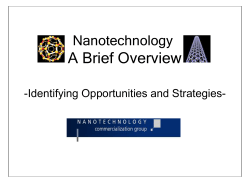
M-RAM – Random (Magnetoresistive Access Memory)
XII2004 M-RAM (Magnetoresistive – Random Access Memory) Information flux. Information Information Information transmission Processing storage DRAM, MRAM Magnetic (HDD) Outside word Input Information Output M-RAM M. Bernacki, S. Wąsek Optical (CD, DVD) Memory categories. WHY DO WEE NEED M-RAM MEMORY ???? M-RAM M. Bernacki, S. Wąsek Basic attractions of M-RAM. Nonvolatility; Speed; Low-power consumption; Scalability. M-RAM M. Bernacki, S. Wąsek Basic attractions of M-RAM. Transfer data to microprocessor without creating a bottleneck! M-RAM M. Bernacki, S. Wąsek History and development... M-RAM based on: M-RAM – quick view. AMR effect - 80-th. Magnetoresistivity. GMR effect - 80-th. TMR effect – 1995 year. M-RAM M. Bernacki, S. Wąsek Storage and states of a bit. MRAM: charge and spin. Storage state: [%] Soft ferromagnet TMR Insulator DRAM: charge of capacitor. „1” Flash, EEPROM: charge on floating gate. Hard ferromagnet FeRAM: charge of a ferroelectric capacitor. „0” Field [Oe] M-RAM M. Bernacki, S. Wąsek Implementation of 1-MTJ / 1-transistor cell. NiFe (free layer) Al2O3 (tunneling barrier) SAF CoFe (fixed layer) Ru CoFe (pinned layer) Word line I I HHclad unclad 2 H clad w2 w M-RAM M. Bernacki, S. Wąsek Write. Word line Without digit line current M-RAM M. Bernacki, S. Wąsek With digit line current Word line RA [kOhm-um2] Write. Easy axis field [Oe] M-RAM M. Bernacki, S. Wąsek Read. Word line Word line M-RAM M. Bernacki, S. Wąsek Sizes of MTJ. 4nm NiFe (free layer) 1..2nm Al2O3 (tunneling barrier) 3nm Ferromagnet I Tunnel barrier CoFe (fixed layer) Ru 3nm CoFe (pinned layer) M-RAM Ferromagnet II M. Bernacki, S. Wąsek Other MRAM cell architectures. Twin cell arrays: Circuit is faster than the 1T1TMR implementation. Less atractive on a cell density and cost basis. Diode cell: SOI diodes allow the integration of a memory with most circuits without sacrificing silicon wafer surface area. SOI diodes suitable for this aplication haven’t been developed yet. Transistorless array: Large reduce in cell area. Complex circuity required to read bit state, slow read. M-RAM M. Bernacki, S. Wąsek MRAM 32Kb memory segment. Bit line 0 Bit line 31 Digit line Word line Word line Digit line M-RAM M. Bernacki, S. Wąsek Reference generator. Bit line RMAX RMIN Digit line Word line Word line Digit line RMAX M-RAM RMIN M. Bernacki, S. Wąsek RREF = 1/2(RMAX + RMIN) 1Mb MRAM architecture. Available modes: Active mode Sleep mode Standby mode M-RAM M. Bernacki, S. Wąsek Examples and performance of M-RAM technology. Motorola semiconductors –2002. 5-level metal CMOS, copper interconnects; Technology: Freescale 0.6um, semiconductors –2003/2004. Technology: Capacity: 1MB0.18mikrons, 5-level metal CMOS, copper interconnects; Capacity: 4MB; Access time: 35ns Access time: 15-20ns M-RAM M. Bernacki, S. Wąsek Roadmap to future storage technologies. RRAM with CMR M-RAM M. Bernacki, S. Wąsek Bio – MRAM, vision for tomorrow? Biomolecule labeled by magnetic markers MRAM array M-RAM M. Bernacki, S. Wąsek References. Wykład z przedmiotu „Magnetyczne nośniki pamięci”, AGH; Materiały z Uniwersytetu Bielefeld: wykład „Thin films and nanostructures”; Materiały seminaryjne z „Motorola Labs”; Materiały z sympozjum „VLSI symposium 2002”; www.freescale.com www.motorola.com M-RAM M. Bernacki, S. Wąsek Dziękujemy za uwagę M-RAM M. Bernacki, S. Wąsek
© Copyright 2025









